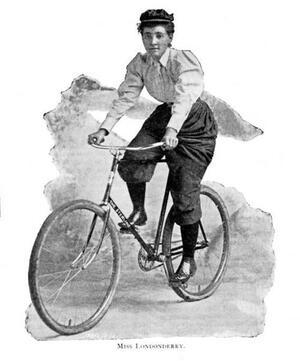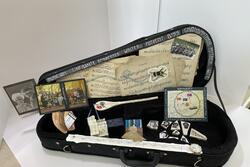Annie Londonderry and the bicycle as a vehicle of social liberation
Annie Cohen Kopchovsky, known as Annie Londonderry, in the final incarnation of her bicycle riding costume. She was the first woman to ride a bicycle around the world in 1856.
Source: Annie Londonderry--the first woman to bicycle around the world, by Peter Zheutlin. © Peter Zheutlin.
Over the past couple years, we have witnessed the rise of an eco-friendly, politically progressive bike culture in the US. In March, 2011, Maria Popova wrote for the Atlantic: “As much as we love bike culture and everything bikes stand for, we may have underestimated the profound significance of the bicycle as a cultural agent of change.”
Earlier this year, Sue Macy’s Wheels of Change: How Women Rode the Bicycle to Freedom (With a Few Flat Tires Along the Way) told the story of the bicycle’s role in women’s emancipation in late-19th-century America. Not only did bicycles give women freedom of transportation and mobility without chaperones, it liberated women from corsets and big skirts. In order to ride more comfortably, women designed new fashions that reduced the weight of their undergarments to a "mere" seven pounds.
"Let me tell you what I think of bicycling. I think it has done more to emancipate women than anything else in the world. I stand and rejoice every time I see a woman ride by on a wheel." --Susan B. Anthony, 1896
One of the pioneering bike-women of the era was Annie Londonderry, a “Jewess with attitude” who is (thankfully) discussed in Wheels of Change. Annie Londonderry (real name Annie Cohen Kopchovsky) was the first woman to ride a bicycle around the world in 1895.
It started with a bet. In 1894, a man in Boston bet $20,000 that no woman could travel around the world by bicycle. This had first been done by a man in 1885. Annie Cohen Kopchovsky set out to prove him wrong on June 25, 1894. Married and the mother of three small children, her choice was particularly daring. Did I mention the fact that she had ridden a bicycle for the first time only days before her trip?
The terms of the bet required Annie to start out penniless and earn money through sponsorships along the way. Resourceful, she hung a placard advertising Londonderry Lithia Spring Water Company from her bicycle, and soon became the company’s representative. She became known as Annie Londonderry. Somewhere along the way, Annie traded her 42 lb ladies bicycle for a men’s bike that weighed half as much, and eventually ditched her skirts and bloomers for a men’s riding costume. She completed her journey in just under 15 months, returning to Boston with $10,000 in prize money. (Visit jwa.org to learn more about her story.)
Her story remains an incredible achievement. Annie Londonderry rode her bike around the world, proving that a woman could undertake such a feat on her own. She fixed mechanical bike problems, survived injury, and dealt with the scrutiny of the press. Her journey was an inspiration, and an example of the way bicycles were a vehicle for liberation.
Even though Annie Londonderry is never mentioned directly in the American Jewess, the first American magazine dedicated Jewish women’s issues, the magazine did discuss bicycles and the threat they posed to traditional femininity and propreity quite a bit. Other women’s publications of the time, like the Ladies’ Home Journal, were less vocal on the issue, implying an unspoken opposition rooted in Victorian sexual mores. (At the time, many were concerned that the placement of the saddle would be sexually stimulating and therefore "unhygeinic.") In the fourth issue of American Jewess, for example, Rosa Sonneschein defended the women cyclists from various criticisms, particularly those about inappropriate dress:
"The Bicycle, or rather the Bloomer girl is at present the most abused of her sex… Poor little Bloomer girl, defenseless, defiant[,] and unadmired, thou glidest through streets, parks[,] and boulevards, the target of the evil eyes of chagrined conservative matrons. Pray let us be kind to the woman on the wheel…"
For more on the American Jewess’s attitude toward women and bicycles, visit jwa.org.
Today, bicycles remain a locus for progressive social change, style and aesthetics, and gender politics. According to Forbes, 80% of the riders in the US today are male. The reasons for the unbalance are not that different than they were in the nineteenth century. Like then, women are still under enormous pressure to maintain a feminine aesthetic, one that is challenged by physical activity. It’s not hard to imagine that many modern women are put off by the idea of arriving at work with sweat stains and “helmet-hair.” Women bicyclists were a heated subject of debate recently in the Hassidic communities of Brooklyn, NY, where women’s sports clothing is still considered an inappropriate form of dress. Bicycles also remain a vehicle to talk about safety and gender-specific safety in public spaces.







